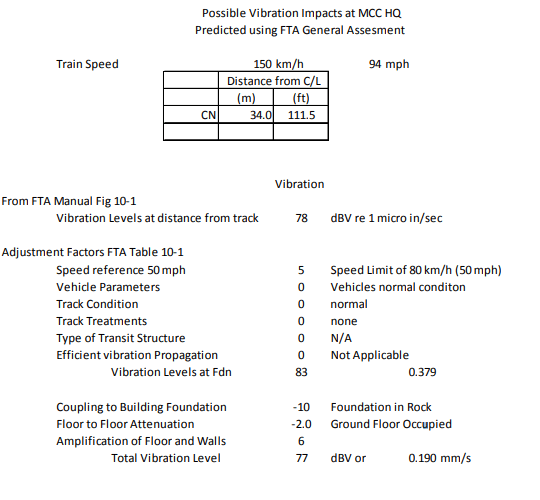Hello. I was wondering if Eng-Tips could help me. I'll confess--I seem to be having a "herp-a-derp" moment. I'm reading a report and I just don't understand how the people converted from VdB re 1 micro inch per second to millimetre per second RMS. I am sure this is a laughable failure on my part.
Per the FTA "Noise and Vibration Manual," Fig 10-1 one can find a generalized ground surface vibration and apply it to their current situation.
(p. 171)
Per the MOE/TTC "Draft Protocol for Noise and Vibration Assessment for the Proposed Scarborough Rapid Transit Extension" May 11, 1993
(a summarized copy is included near the end of the document, p. 58 onward)
In the MOE draft p. 6 (p. 62 of the PDF), they state that "If the predicted rms vertical vibration velocity from the Line exceeds 0.1mm/sec, mitigation methods shall be applied during the detailed design to meet this criterion to the extent technologically, economically, and administratively feasible."
I'm reading a report and I'm not understanding how they arrived at their number (please see attached calcs).

When I convert micro inch to mm, I go by 1 micro inch = 0.0000254mm
So (77 micro in./sec) * (0.0000254 mm/micro in.) = .0019558 mm/sec
The report calls it out as 0.19mm/sec. So what am I missing? Is it not just a simple distance conversion for VdB re 1 micro in./s to mm/s? Or is there a formula I'm missing?
They also have this statement: "These standards indicate that the appropriate criteria for office buildings are 84 dBV (referred to 1 micro inch per second) or 0.4 mm/s RMS for vibrations."
I'm even more lost on this one. I presume the "83 dBV re 1 micro in./sec" from the previously attached pic also is calculated to 0.379 is a similar situation.
I'm guess I'm lost because, by Fig 10-1, converting the way I am there is no situation where the rail vibration exceeds TTC standards. I mean, 10 ft away when the train is doing 95mph passes the 0.1mm/s benchmark. So, I think I'm just missing something. Any help greatly appreciated.
Per the FTA "Noise and Vibration Manual," Fig 10-1 one can find a generalized ground surface vibration and apply it to their current situation.
(p. 171)
Per the MOE/TTC "Draft Protocol for Noise and Vibration Assessment for the Proposed Scarborough Rapid Transit Extension" May 11, 1993
(a summarized copy is included near the end of the document, p. 58 onward)
In the MOE draft p. 6 (p. 62 of the PDF), they state that "If the predicted rms vertical vibration velocity from the Line exceeds 0.1mm/sec, mitigation methods shall be applied during the detailed design to meet this criterion to the extent technologically, economically, and administratively feasible."
I'm reading a report and I'm not understanding how they arrived at their number (please see attached calcs).

When I convert micro inch to mm, I go by 1 micro inch = 0.0000254mm
So (77 micro in./sec) * (0.0000254 mm/micro in.) = .0019558 mm/sec
The report calls it out as 0.19mm/sec. So what am I missing? Is it not just a simple distance conversion for VdB re 1 micro in./s to mm/s? Or is there a formula I'm missing?
They also have this statement: "These standards indicate that the appropriate criteria for office buildings are 84 dBV (referred to 1 micro inch per second) or 0.4 mm/s RMS for vibrations."
I'm even more lost on this one. I presume the "83 dBV re 1 micro in./sec" from the previously attached pic also is calculated to 0.379 is a similar situation.
I'm guess I'm lost because, by Fig 10-1, converting the way I am there is no situation where the rail vibration exceeds TTC standards. I mean, 10 ft away when the train is doing 95mph passes the 0.1mm/s benchmark. So, I think I'm just missing something. Any help greatly appreciated.
